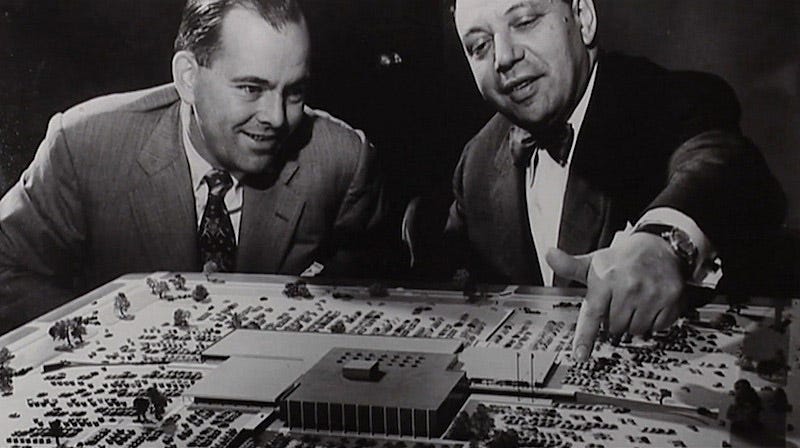Part 1: Shopping Mall Series
A brief history of the shopping mall, up to 1956, when the first modern era enclosed mall was opened to the public in Minnesota.
In this three-part series we will examine the shopping mall experiment and pass judgment on whether it has been a success based on the original intent of the founder. The parts are:
👉 A Brief History of the Shopping Mall
In the Beginning (1924 - 1945)
The first wave of malls in America were all open-air shopping malls attempting to recreate traditional downtown shopping experiences outside of town. Most were built to draw people to reside and plant roots in newly formed and growing small cities. They were used as magnets of people more than profit generators. Most of the value for these developers was realized from the increase in demand for the surrounding land where the mall sat.
The first mall of this type was the Country Club Plaza, opened in 1924, and developed by the J.C. Nichols Company. The mall was built 5 miles south of Kansas City, Missouri in a sparsely populated area. The building sat on 30 acres (i.e., 12 hectares) and nearly half of which was for parking and wide streets. Projects costs were $5 million, or about $89 million in today’s dollars.
The grocery store was called Piggly Wiggle and its interior is pictured below.
An important design element to note is that all of the shops in these early malls faced outward to the street. The first mall which faced in on itself was the Highland Park Shopping Village opened several miles north of Dallas, Texas in 1931. This design style (i.e., inwardly facing open-air malls) became the norm for most malls later built in this era.
The Highland Park Shopping Village still operates today and is located in what is now one of the wealthiest neighborhoods in America. In 1976, the mall was acquired by a developer for $5 million. In 2009, a consortium which included Ray Washburne, a wealthy real estate billionaire in Texas, purchased the property for an astounding $170 million. Ray Washburne was President Trump’s pick to lead the Overseas Private Investment Corportation (“OPIC”), now called the DFC.
Post-WWII Era (1945 - 1955)
Following the Second World War the American servicemen returned to a country poised for economic growth. Russia had defeated the Nazis, and the Americans Japan through nuclear warfare. The GI Bill facilitated home purchases and many servicemen decided to live in the outskirts of cities. Automobile use and ownership was common and increasing. The environment was ideal for suburbs to flourish, and that they did.
Shopper’s World was opened in Massachusetts in 1951 as one of the first suburban malls, and the first to offer more than one level of shopping. Its sole anchor was the Jordan Marsh dome which was reputed to be the third largest unsupported dome in the world after St. Peter’s Basilica (Rome) and St. Paul’s Cathedral (London).
The two levels of shopping can be seen in the below photo as well as the dome in the distance.
The next big development, bringing us close to what we modernly conceive of as a mall, was from The Northland Center in Michigan. The mall was opened in 1954 as the largest shopping center in America, and was anchored by a four-level department store which was the largest in the world at 480,000 ft² (i.e., 45,000 m²). The anchor was in the center of the development with the parking and other stores radiating from it.
Modern Era Enclosed Malls (1956 & Beyond)
The first enclosed modern era mall dates back to 1956 when The Southdale Center opened in Edina, Minnesota, a suburb of Minneapolis. The mall was designed by Victor Gruen who is considered the “grandfather” of malls. Next week we’ll look closer at Gruen’s interesting background and philosophy of mall design.
The mall’s climate-controlled environments allowed shoppers a respite from biting winter weather, and a place for bargain hunters, families, and teenagers to gather. Two department stores were placed at opposite ends of the mall and pitted against each other. Gruen’s idea was that as shoppers compared prices in both department stores, that they would walk past the other shops and make more purchases. The “Gruen Transfer” (or “Gruen Effect”) is utilized to this day in mall design and involves creating traffic flows in the mall and adding as many distractions as possible so that the shopper becomes disoriented and is thus more likely to make impulsive purchases. This is a well-researched phenomenon in the field of psychology with copious amounts of literature for those interested to know more. If you’ve ever found yourself disoriented in a shopping mall and unable to get your bearings or find an exit, it was likely intentional from the Gruen-inspired architect!
The Southdale Center had two department stores and seventy-two total stores. The mall had 800,000 ft² (i.e., 74,000 m²) of GLA, and 5,200 parking spaces. The mall included a three-story garden court with tall eucalypts and magnolias, as well as two enormous metal sculptures by American artist Harry Bertoia. It included a bird aviary and was a frequent host for art and other types of exhibitions. The mall is now owned by Simon Property Group, the largest retail REIT in the world.
Following the Southdale Centre opening, at least one new mall of this style was built in America every year until 2007. In that time, malls continued to evolve and several important trends emerged which I may decide to discuss in a future edition of the Emerging Real Estate Digest.











